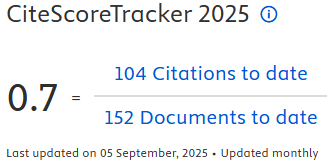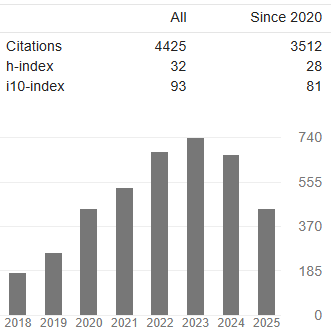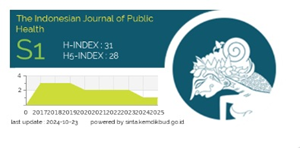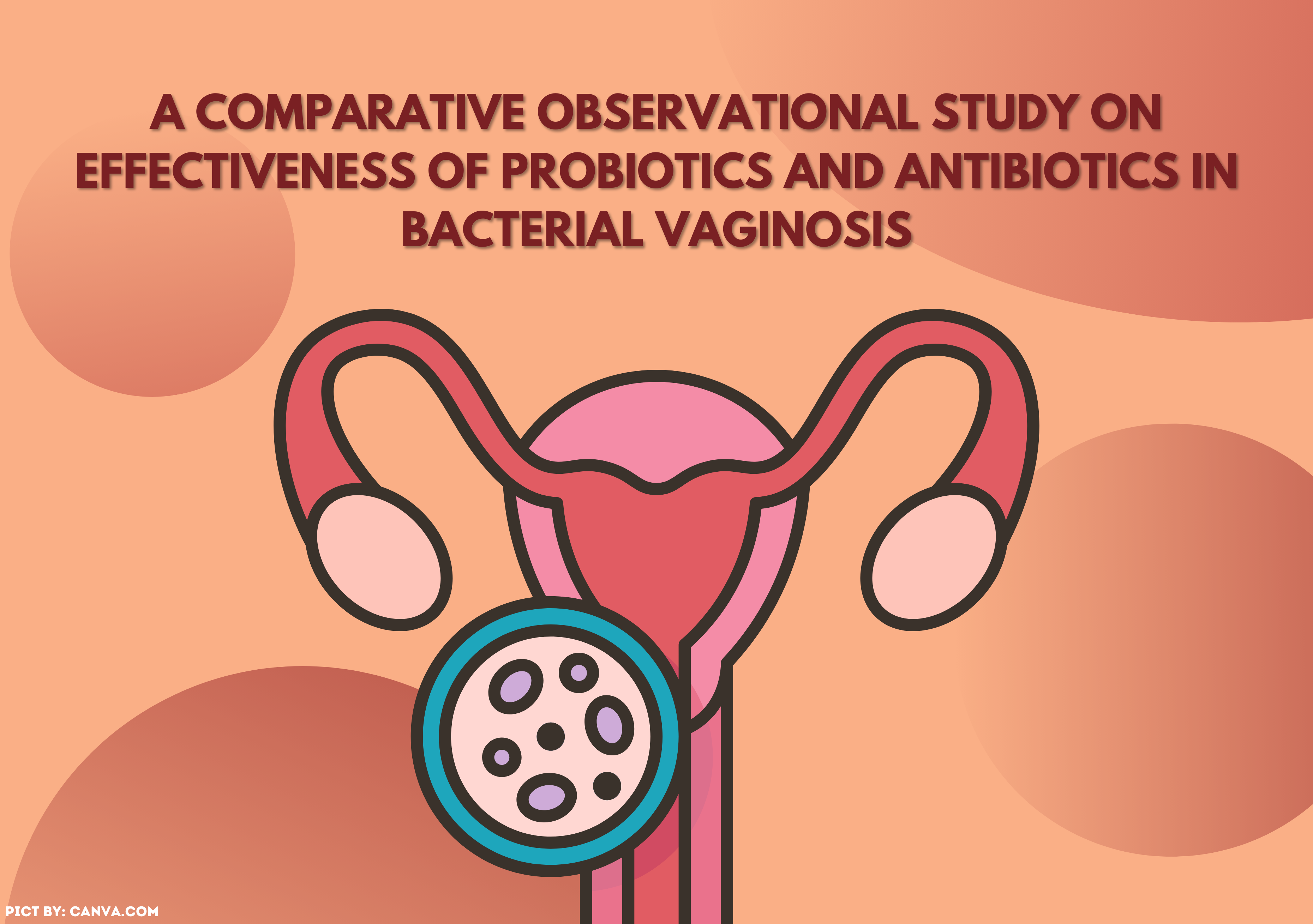PENGARUH AKTIVITAS FISIK TERHADAP RISIKO OBESITAS PADA USIA DEWASA
Downloads
Indonesia has an increasing number of obese people every year. Risk factors and complications caused by obesity can increase morbidity and mortality in the community. One of factors causing the increasing number of obese people is caused by the decreasing level of physical activities done by Indonesian people.This study aims to determine the effect of physical activity levels on the risk of obesity. The study used an observational analytic case control design. Subjects were chosen through a purposive sampling method. The population was young adults in Surabaya. The sample of the study included 97 obese adults and 97 non-obese adults. The study was conducted in March - July 2018 in South Surabaya through distributing questionnaires to two groups. The questionnaire given used the Global Physical Activity Questionnaire (GPAQ). The results showed that physical activity performed by adult age group of obesity was mostly classified as low activity (59,8%), while non-obese adult age group was mostly included in medium activity (56,6%).This shows a significant difference in physical activity between obese and non-obese groups (p=0,047). It can be concluded that decreased levels of physical activity may increase the risk of obesity in adult.
Adamo E.D., Guardamagna O., Ciarelli F., Bartuli A., Liccardo D., Ferrari F., and Nobili V. (2015). Atherogenic Dyslipidemia and Cardiovascular Risk Factors in Obese Children. International Journal of Endocrinology. ID 912047. [http://dx.doi.org/10.1155/2015/912047]
Al-Goblan A.S., Al-Alfi M.A. and Khan M.Z. (2014). Mechanism linking diabetes mellitus and obesity. Diabetes Metab Syndr Obes. 7: 587–591.
Bustillos A.S., Vargas K.G. and Cuadra R.G. (2015). Work productivity among adults with varied Body Mass Index: Results from a Canadian population-based survey. Journal of Epidemiology and Global Health. 5(2):191-199. [https://DOI:10.1016/j.jegh.2014.08.001]
Dietary Guidelines. (2015). Physial Activity Guidelines for Americans.
Elder B.L., Ammar E.M., and Pile D. (2016). Sleep Duration, Activity Levels and Measures of Obesity in Adults. Public Health Nurs. 33(3):200-205. [https:// DOI:10.1111/phn.12230]
Ermona ND. And Wirjatmadi B. (2018). Hubungan Aktivitas Fisik Dan Asupan Gizi Dengan Status Gizi Lebih Pada Anak Usia Sekolah Dasar di SDN Ketabang 1 Kota Surabaya tahun 2017. Amerta Nutrition. 2(1):97-105. [https:// DOI : 10.2473/amnt.v2i1.2018.97-105]
Gebel K. Ding D., Chey T., et al. (2015). Effect of Moderate to Vigorous Physical Activity on All-Cause Mortality in Middle-aged and Older Australians. JAMA Internal Medicine. 175(6):970-977.[https:// DOI:10.1001/jamainternmed.2015.0541]
Gillman and Ludwig. (2013). How early should obesity prevention start. New England Journal of Medicine. 369(23):2173–2175. [https:// DOI:10.1056/NEJMp1310577]
Hamasaki H. (2016). Daily physical activity and type 2 diabetes: A review. World J Diabetes. 2016 Jun 25; 7(12): 243–251. [https:// doi: 10.4239/wjd.v7.i12.243]
Hruby A., and Hu F.B. (2015). The Epidemiology of Obesity: A Big Picture. Pharmacoeconomics. 33(7): 673–689. [https:// DOI:10.1007/s40273-014-0243-x]
Huang C.J., McAllister M.J., Slusher A.L., Webb H.E., Mock J.T. and Aevedo E.O. (2015). Obesity-Related Oxidative Stress: the Impact of Physical Activity and Diet Manipulation. Sport Medicine Open, Springer. 1:32.
Kumah D.B., Akuffo K.O., Abaka-can J.E., Affram D.E. and Osae E.A. (2015). Prevalence of Overweight and Obesity among Students in the Kumasi Metropolis. Jurnal of Nutrition and Metabolism. Vol 2015:1-4. [http://dx.doi.org/10.1155/2015/613207]
Maier J.H. and Barry R. (2015). Associations among Physical Activity, Diet, and Obesity Measures Change during Adolescence. Journal of Nutrition and Metabolism. PMC4619959. [https://doi: 10.1155/2015/805065]
McAuley P.A., Chen H., Lee D.C., Artero E.G., Bluemke D.A., and Burke G.L (2014). Physical activity, measures of obesity, and cardiometabolic risk: the Multi-Ethnic Study of Atherosclerosis (MESA). J Phys Act Health. 11(4):831-7. [https:// DOI:10.1123/jpah.2012-0326]
Mi Y.D., Zhang B, Wang H.J., Yan J., Han W., Zhao J., Liu D.W. and Tian Q.B. (2015). Prevalence and Secular Trends in Obesity Among Chinese Adults, 1991–2011. Am J Prev Med. 49(5): 661–669. [https:// DOI:10.1016/j.amepre.2015.05.005]
Mitchell N., Catenacci V., Wyatt H.R., and Hill J.O. (2011). Obesity: Overview of an Epidemic. Psychiatr Clin North Am. 2011 Dec; 34(4): 717–732. [https:// doi: 10.1016/j.psc.2011.08.005]
Pedoman praktis terapi gizi medis Departemen Kesehatan RI 2003. Kementrian Kesehatan Republik Indonesia
Pulgaron E.R. and Delamater A.M. (2014). Obesity and Type 2 Diabetes in Children: Epidemiology and Treatment. Curr Diab Rep. 14(8): 508. [https:// doi: 10.1007/s11892-014-0508-y]
Rachmi C.N., Li M., and Baur A. (2017). Overweight and obesity in Indonesia: prevalence and risk factors”a literature review. Public Health, Elsevier. 147:20-29. [https:// doi: 10.1016/j.puhe.2017.02.002]
Sahoo K., Sahoo B., Choudhury A.K., Sofi N.Y., Kumar R., and Bhadoria A.S. (2015). Childhood obesity: causes and consequences. Journal of family medicine and Primary care. 4(2): 187–192. [https:// doi: 10.4103/2249-4863.154628]
Sand A.S., Emaus N. And Lian L. (2015). Overweight and obesity in young adult women: A matter of health or appearance? The Tromsí¸ study: Fit futures. International Journal of Qualitative Studies on Health and Well-being. 10:1-12. [https:// doi: 10.3402/qhw.v10.29026]
Sartorius B., Sartorius K., Aldous C, Madiba T.E., Stefan C., and Noakes T. (2017). Carbohydrate intake, obesity, metabolic syndrome and cancer risk? A two-part systematic review and meta-analysis protocol to estimate attributability. BMJ Open. 6:e009301.
Stanhope K.L. (2015). Sugar consumption, metabolic disease and obesity: The state of the controversy. Crit Rev Clin Lab Sci. 53(1):52-67.[https:// doi:10.3109/10408363.2015.1084990]
Strasser B. (2013). Physical activity in obesity and metabolic syndrome. Ann. N.Y. Acad. Sci. 1281: 141–159. [https:// doi: 10.1111/j.1749-6632.2012.06785.x]
Stevens G.A., Singh G.M., Lu Y., Danaei G., Lin J.K., Finucane M.M., et al. (2012). National, regional, and global trends in adult overweight and obesity prevalences. Popul Health Metr. 10(1):22. [https:// doi: 10.1186/1478-7954-10-22]
Suryadinata R.V., Wirjatmadi B., and Adriani M. (2017a). Efektivitas Penurunan Malondialdehyde dengan Kombinasi Suplemen Antioksidan Superoxide Dismutase Melon dan Gliadin Akibat Paparan Rokok. Global Medical and Health Communication. 5(2):79–83
Suryadinata R.V., Lorensia A., and Sari R.K. (2017b). Perbedaan Asupan Nutrisi Makanan dan Indeks Massa Tubuh (IMT) Antara Perokok Aktif dengan Non-perokok pada Usia Dewasa. Jurnal Farmasi Klinik Indonesia. 6(3):171–180. [https:// DOI: 10.15416/ijcp.2017.6.3.171]
Swift D.L., Johannsen N.M., Lavie .J., Earnest C.P. and Church T.S. (2014). The Role of Exercise and Physical Activity in Weight Loss and Maintenance. Prog Cardiovasc Dis. 56(4): 441–447.[https:// doi: 10.1016/j.pcad.2013.09.012]
The GBD 2013 Obesity Collaboration. (2014). Global, regional and national prevalence of overweight and obesity in children and adults 1980-2013: A systematic analysis. Lancet. 384 (9945) : 766–781. [https:// doi: 10.1016/S0140-6736(14)60460-8]
WHO. (2017) World Health Organization : Global Strategy on Diet, Physical Activity and Health.
Wickman C. And Kramer H. (2013). Obesity and kidney disease: potential mechanisms. Semin Nephrol. 33(1):14-22. [https:// doi: 10.1016/j.semnephrol.2012.12.006.]
Xiao Y., Qiao Y., Pan L., Liu J., Zhang T., Li N., Liu E., Wang Y., Liu H., Liu G., Huang G., and Hu G. (2015). Trends in the Prevalence of Overweight and Obesity among Chinese Preschool Children from 2006 to 2014. PLoS One. 10:8. [https://doi.org/10.1371/journal.pone.0134466]
- The authors agree to transfer the transfer copyright of the article to The Indonesian Journal of Public Health effective if and when the paper is accepted for publication.
- Authors and other parties are bound to the Creative Commons Attribution-NonCommercial-ShareAlike 4.0 International License for the published articles, legal formal aspect of journal publication accessibility refers to Creative Commons Attribution-NonCommercial-ShareAlike 4.0 International License (CC BY-NC-SA), implies that:
- Attribution ” You must give appropriate credit, provide a link to the license, and indicate if changes were made. You may do so in any reasonable manner, but not in any way that suggests the licensor endorses you or your use.
- NonCommercial ” You may not use the material for commercial purposes.
- ShareAlike ” If you remix, transform, or build upon the material, you must distribute your contributions under the same license as the original.































